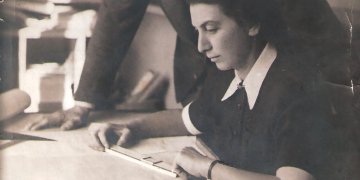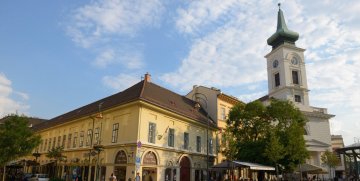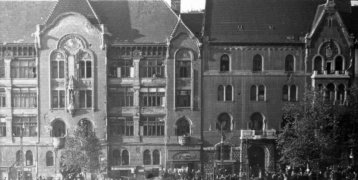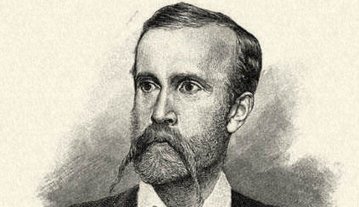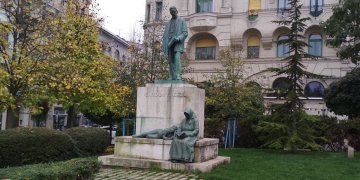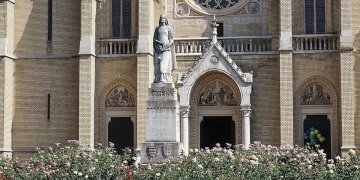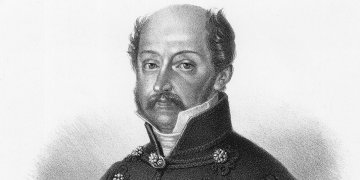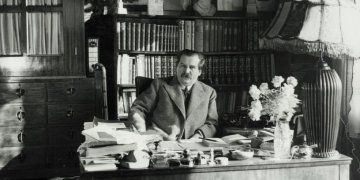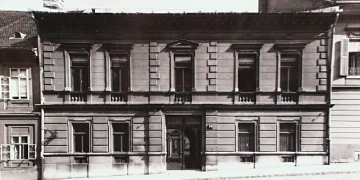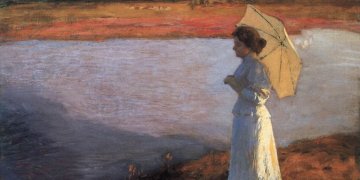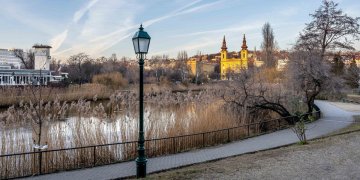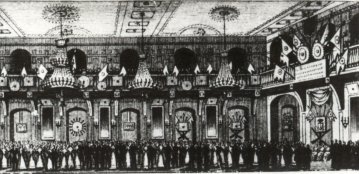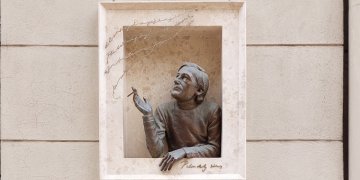Flóra Simon
Cikkek
The first Hungarian female engineer was born 125 years ago - She wanted to build bridges, roads and railways
March 8, 2023 at 3:00 PM
Eszter Pécsi, the first Hungarian female engineer, received her statics degree at Royal Joseph Polytechnic University on her 22nd birthday, making her the first female graduate engineer in the country. She notes the plans for the statics of the Alfréd Hajós Swimming Pool, but after 1945 she also took part in the revision of the capital's damaged buildings, as well as in the reinforcement work of the cracked roof of the National Theatre. She was responsible for the construction of several villas in the capital, such as the recently renovated Rózsi Walter Villa, which was designed by her husband, József Fischer. In Pestbuda's article, we remember the first Hungarian female engineer.
Károli Gáspár University of the Reformed Church turns 30 years old
February 27, 2023 at 3:00 PM
Thirty years ago, the Synod of the Reformed Church, at its meeting on 24 February 1993, decided to found the Károli Gáspár University of the Reformed Church on the foundations of the Pest Reformed Theological Academy. The choice of name caused some controversy, but his work, the first complete Hungarian Bible translation, was in favour of Gáspár Károli, as it serves as the basis of universal Hungarian culture. University education started at 28 Ráday Street, the former seat of the theological academy, but due to the growing number of students, new locations had to be found. Nowadays, the students of the reformed university can study in such patinated buildings as the Károlyi-Csekonics Palace on Reviczky Street or the former Municipal School for Girls on Aréna Street.
The father of the Lágymányos residential houses, architect József Fischer was born 150 years ago
February 14, 2023 at 12:30 PM
Architect József Fischer was one of the important creators of the large-scale residential house constructions that began at the beginning of the 20th century. His buildings still define the image of Lágymányos. If people walk from the direction of Szent Gellért Square on Bartók Béla Road towards Móricz Zsigmond Square, or walk over to Budafoki Road, from here they turn into Zenta Street, they can see several residential houses that he listed. He designed around 25 houses in the capital, most of which are still standing today. Pestbuda now commemorates József Fischer, who was born 150 years ago.
Imre Madách, born 200 years ago, became a writer in Pest
January 28, 2023 at 9:00 AM
The young Imre Madách lived in Pest for three years. While completing his law studies at the University of Pest, he also got involved in social and cultural life. He regularly visited the performances of the Hungarian Theatre of Pest, attended concerts at the National Casino, but the highly educated young man also learned to paint, fence, and play the piano in the capital. His first volume was published here. Pestbuda remembers Imre Madách, who was born 200 years ago.
An emblematic building, the Mushroom at Móricz Zsigmond Square is 80 years old
December 8, 2022 at 12:30 PM
Újbuda's emblematic building, the Mushroom [Gomba], is eighty years old this December. The traffic pavilion erected in 1942 at Móricz Zsigmond Square performed its original function for sixty years until the tracks running around it were demolished. The building remained unoccupied. By the time it came under the ownership of the 11th District Local Council from the capital, it was dilapidated, dirty, and unworthy of its architectural value and the atomic sphere of the place. A design competition was launched to save it, as a result of which the contemporary public space was born in 2014, which satisfies both elegant, functional and cultural needs.
The hermit of Eger was a regular guest of Pest's coffee houses - Géza Gárdonyi died a hundred years ago
October 30, 2022 at 10:00 AM
Although his name lives on in the public consciousness as a hermit of Eger, Géza Gárdonyi was a regular figure in the cultural and literary life of Budapest at the turn of the 19th century. He was an eyewitness to the development of the city, as a journalist he reported for years from the Old House of Representatives, he visited the famous artist's salon of the Fesztys, but he was also considered a regular guest at the Centrál, the Valéria or the New York Café. Pestbuda now remembers Géza Gárdonyi, who died 100 years ago today.
Sculptor József Damkó was born 150 years ago - His works can be admired all over the capital
October 17, 2022 at 2:00 PM
Undeservedly little is said about sculptor József Damkó, even though the artist produced many works that stand at important points in the Hungarian capital. Such is the statue of Saint Elizabeth of the House of Árpád on Rózsák Square, the statue of St. John of Capistrano on Kapisztrán Square in Buda Castle or the statue of Pope Innocent XI on Hess András Square. His architectural sculptures and tombstones are also of considerable value. Pestbuda now presents the Budapest works of József Damkó on the 150th anniversary of his birth.
The Pest audience adored his love poems - Sándor Kisfaludy was born 250 years ago
September 27, 2022 at 11:00 AM
Sándor Kisfaludy's first volume, Himfy szerelmei - A kesergő szerelem [Himfy's Loves - The Bitter Love], published in Buda in 1801, was a worthy opening of 19th-century Hungarian literature. Kisfaludy, who described his passionate love life in lyrical form, became an influential scientist and writer at a young age and was elected a member of the Hungarian Society of Scientists and the Kisfaludy Society. With his support, his brother Károly Kisfaludy published his famous yearbook, Aurora, which promoted Hungarian literature. Sándor Kisfaludy was born 250 years ago today.
The Pest homes of Zsigmond Móricz, who died 80 years ago
September 15, 2022 at 9:00 AM
Not only Dezső Kosztolányi (Üllői úti fák [Trees of The Üllői Road]) but also Zsigmond Móricz could come to our mind when we think of Üllői Road. One of the most famous authors of 20th-century Hungarian realist prose literature lived for twenty years in his home on Üllői Road, where such defining works as Tragédia [Tragedy] and Légy jó mindhalálig [Be Faithful Unto Death] were written. After the suicide of his first wife, the writer moved to an apartment building on Fővám Square with his daughters and then lived for a short time in an apartment in a pre-modern style house on Bartók Béla Road. Zsigmond Móricz, whose name is preserved by public works, public institutions, literary scholarships and numerous public spaces, died eighty years ago.
Gothic behind the gate - One of the most researched residential buildings of the Buda Castle is being renovated
May 25, 2022 at 9:00 AM
The one-storey listed building at 9 Országház Street will be renovated. One of the most researched residential buildings in the Buda Castle District was built in the 15th century, then rebuilt in the Baroque style in the 17th century. It underwent another major transformation in the 19th century. The Gothic sedilia in the front door of the house are of outstanding value in the Castle District, but its facade is also remarkable.
Béla Iványi-Grünwald, a popular figure in art life in Budapest, was born 155 years ago
May 16, 2022 at 12:00 PM
Among the innovators of Hungarian painting at the turn of the century, we consider Béla Iványi-Grünwald, who was born 155 years ago. He studied at the Mintarajziskola [Design School] on Andrássy Avenue, later becoming a popular and defining figure in Budapest's art life, one of the founders and core members of the Fészek Klub [Nest Club]. He is also the founder of the Nemzeti Szalon [National Salon], an association of artists dissatisfied with official art policy, with its headquarters in Erzsébet Square. When he died at János Hospital in 1940, his contemporaries said goodbye not only to a talented artist but also to an always cheerful social man.
A pharmacy was opened in the Inner City of Pest more than three hundred years ago
March 19, 2022 at 12:00 PM
On the plot of the corner building at 32 Váci Street - 2 Kígyó Street after the Turkish occupation the first public pharmacy in Pest, the Szentháromság [Holy Trinity] pharmacy operated. Its builder and owner was the pharmacist, Heinrich Siegfried Herold. The plot is well-located and has housed a number of shops and high-ranked tenants in recent centuries since the pharmacy moved out: the fabric store addressed to the Green tree [a Zöld fához in Hungarian], the sign of which was painted by Miklós Barabás, and a bookshop of the famous bookseller family, the Kiliáns where also housed here. The building, which is still in a very dilapidated condition, is under the district's unique protection and is a prominent archaeological site.
The Bottomless Lake: a romantic landscape in Újbuda
January 21, 2022 at 9:00 AM
One of the emblematic sites of Szentimreváros in the 11th District is the Bottomless Lake, which was artificially created in the late 19th century. The workers of the brick factory operating on the site of today's Kosztolányi Dezső Square accidentally cut through a deep watercourse, the stratum water burst to the surface and slowly filled the clay bed. The Bottomless Lake and its shores were neglected until the middle of the last century, where rubble and ruins were carried here during the two world wars. However, between 1958 and 1960, it was put in order and a park was established around it, and since then it has been a popular place for the citizens.
Where the 12-year-old Liszt also played - The Seven Electors' Inn was the centre of social life in Pest
December 19, 2021 at 11:00 AM
The most prestigious balls of Pest in the first decades of the 1800s were held in Downtown, at 9 Váci Street, on the floor of The Seven Electors' Inn (Hét választófejedelem fogadó). Joseph II also stayed at the inn, 12-year-old Ferenc Liszt gave his first concert in Pest here. The audience could also admire the plans of the first permanent bridge between Pest-Buda in the Great Hall of The Seven Electors' Inn. The house was demolished in 1840, and the three-storey classicist residential house of József Hild was built in its place, which houses the Pesti Theatre nowadays.
The poet and Budapest - János Pilinszky was born 100 years ago
November 27, 2021 at 9:00 AM
Budapest gave Pilinszky the experience of the city: when he was young, he absorbed the colours and atmosphere, and although he got to know many big cities in the world (he visited Rome, Paris, London, Vienna or New York), the real remained Budapest for him. The poet, born 100 years ago, spent his infancy in the city centre, in the immediate vicinity of the Károlyi Garden, he lived with his family for long in Molnár Street, he got his first home on Izabella Street at the age of forty. Cafés, editorial offices, bars and cinemas were also important venues for his life and poetry.

